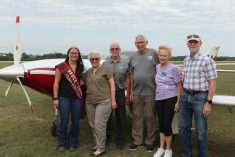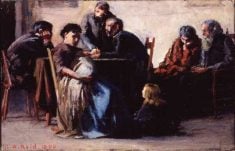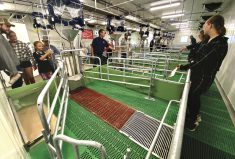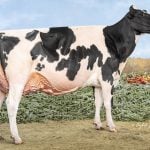Scattered across the Ontario countryside are the hollow remnants of farming’s pioneer roots.
Old, derelict buildings with beams missing, precariously standing atop crumbing foundations. Most are lost to demolition by neglect, controlled burns or the bulldozer. However the not-for-profit organization Ontario Barn Preservation is working to ensure that the number of barns lost to this fate is reduced.
Why it matters: Of the nearly 500,000 barns that were built before 1900, it’s believed 1,000 remain.
The organization is empowering an army of barn owners to record the history of their buildings in a digital database, called the Your Old Barn Study (YOBS).
“OBP believes that in future, YOBS will help bring barns back to life through smart 3-D software, and as the database grows, it will become a researcher and historian’s dream to study all kinds of interesting things,” says Hugh W. Fraser, president of Ontario Barn Preservation (OBP). He’s the owner of St. Catherine’s-based OTB Farm Solutions, a farm best practices consultant and certified auditor for Sustainable Winegrowing Ontario.
The Your Old Barn Study project is recording characteristics and history of barns in digital format to maintain the information long after the barns and their owners are around.
The initiative won the 2023 Public Education and Engagement Award from Architectural Conservancy Ontario.
About 150 old barns are in the database with more being added all the time. Key features of each barn are recorded including dimensions, age, construction style, roof slope and style, strategically located photos from inside and outside, and a list of signature features inside and out.
The Your Old Barn Study aims to empower barn owners to fill in the data themselves, versus sending out a handful of barn experts to scour the land for old barns.
“The army of barn owners may not record things to the same detail, but they can cover a lot more ground in a shorter time period. Our old barns cannot wait any longer,” said Fraser.
“It is difficult, if not impossible, to ‘save’ any barns unless you know how many there are, where they are, how old they are, which ones are in great shape, which need some work, which are in danger of falling down, and which are important to save for cultural and architectural significance, and their contribution to our rural landscape,” he said.
Any publicity about the cause brings attention to barn owners, developers and governments.
A young organization preserving old barns
Ontario Barn Preservation started as a non-profit in 2019, just before the beginning of the COVID-19 pandemic.
“Compared to the 175 years of old barns built in Ontario (1786—1961), this is an infinitesimal amount of time,” he said.
The organization defines old barns as before the census of 1961, but he said, “saving” barns means different things to people.
“It is not simply swooping in at the nick of time to stop a wrecking ball from taking a barn down so a subdivision can be built. Saving is much broader and starts long before that,” he said.
Catching them way before that point is where success happens as barn owners learned how to preserve them to continue to stand for years.
Preservation also means creating pride of ownership, and finding ways to renovate and repurpose the barn so that they are economically viable.
“It means restoring them for continued use for agriculture. It means showing barn owners what gems they possess and the unique things in their barns,” he said.
Fraser points to several restoration efforts that allowed old barns to be converted into farm markets, wedding venues, offices, homes, apartments and public spaces. He added that some barns have been dismantled, moved and resurrected on other properties.
Fraser says that saving barns can mean designating it because of its special design or physical value, historical or associative value and/or contextual value, but designation is a specific and rare thing for old barns. He said it can also include influencing government policies and engaging interested stakeholders.
“In OBP’s mind, any barn that gets saved in any way is a bonus.”
Fraser said the organization is confident their reach into rural Ontario has already helped save hundreds of barns, but actual numbers are very difficult to track.
The group’s efforts have been well received by the farming community. Despite being just a small group, he said their non-aggressive approach has helped ensure that positive response.
“We have fewer than 100 members, but of course we’d like more. Annual membership fees are less than lunch for two at a fast-food joint, but we have never believed the number of members is a particularly good measure of success,” he said.
Many farms across Ontario have fallen victim to developers, with farmscapes transformed into housing developments. He said that OBP is not an adversary of the developer, but an ally.
“We know all old barns out there cannot be saved, nor should they all be saved. But there are truly special old barns that at the very least need to be documented through our YOBS program, because once a barn is gone, it is gone, and all its stories and wonder are gone too. We hope some developers will see fit to help us save a few barns on their properties and turn them into gems for new communities,” he said.
Moving forward, the group is taking on the bold ambition of recording barns that pre-date 1891, a time when there were approximately 442,000 barns and stables across a province with a population of about 2.1 million people.
“Barns and stables were not defined, but in those days, there were lots of horses in towns and cities, so stables were likely for carriages and horses,” he said. “It is hard to believe, but there were over 2,300 barns and stables in the nine wards of downtown Toronto in 1891.”
The peak for Ontario barn numbers may have been around 1900 with about 500,000 barns and stables.
Most of the decline has been in the past 75 years as Ontairo’s population has grown from 4.9 million in 1950 to 16.9 million doay.
“We know the disappearance of old barns is inversely proportional to population growth, so there is little doubt we have fewer than 100,000 barns remaining, but how many fewer?”
Learning when barns go and why
Fraser said the Your Old Barn Study project is a barn counting exercise with a few representative townships, some that have never been under urban threat, others that have.
“Very preliminary results are interesting, beyond just numbers. The study is spawning more questions. What type of farms are more likely to lose barns? Does the desperate need for housing and long commuting distances to work speed the decline? Do many lot severances speed decline? The hope is this study will lead to other studies that will help shape future rural policies with respect to barns,” he said.
The OBP will help a farmer if they want to designate their barn, however, OBP does not advocate for designation without an owner’s willingness to designate.
To learn more about barn designation, reach out to your municipality. For additional information on the OBP program visit https://www.ontariobarnpreservation.com/















